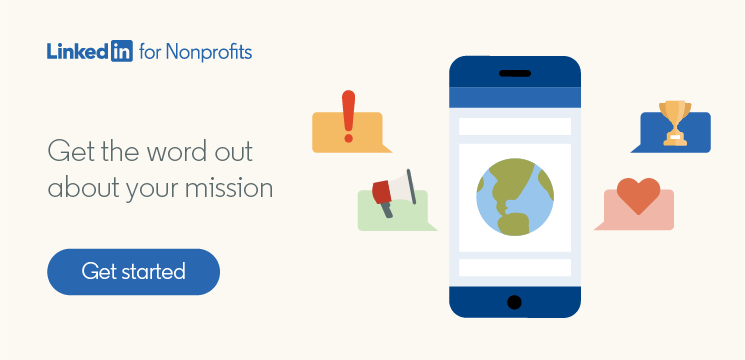
Which Social Media Platforms Should Your Nonprofit Use?
Social media is one of the most influential marketing tools around today. As a nonprofit, you can use social media to raise awareness, attract donors, recruit volunteers, and so much more. But with so many platforms out there and only so much time in the day, which platforms should you focus on?
If your marketing team is already stretched thin, don’t feel the need to try and conquer every social media platform under the sun. Cultivating a compelling presence on a few core channels is enough, at least to get started with. As you grow more social media savvy or your team expands, you might decide to branch out. But starting small and strong is better than not starting at all—or trying to do too much and burning out.
To help you make the right decisions for your organization, here’s a quick guide to some of the most popular platforms.

With a membership of 756 million global professionals, LinkedIn is the ideal platform for reaching both potential corporate partners and working professionals who might be interested in donating, volunteering, or even coming to work for your organization. More than half (53%) of all LinkedIn members donate to nonprofits, and 60% are interested in volunteering. Members are interested in seeing your nonprofit’s content, and since LinkedIn is a highly trusted platform, it’s a great place to build an engaged and active community of supporters.
Like some of the other platforms on this list, LinkedIn allows you to post a wide range of content and create groups to foster discussion, engagement, and action. With LinkedIn Live, you can even stream live broadcasts to your followers. One of the features that sets LinkedIn apart from other platforms is the ability to create a LinkedIn Page for your nonprofit that not only includes a robust summary of your mission and work alongside your posts and videos, but also a separate tab where you can share insights about what it’s like to work at your organization. Since you can also post jobs on LinkedIn and candidates are likely to research your organization directly on the platform when deciding whether or not to apply, it’s best to have a complete and up-to-date LinkedIn Page for your nonprofit, even if you only post content from the account once or twice a week.
Facebook is less trusted than some social media platforms, but that doesn’t mean that you can’t build a trustworthy profile for your nonprofit on the platform. With a few billion active users, the platform is a good place to get people talking and sharing content about your cause.
Facebook also has built-in fundraising tools that your nonprofit can use to encourage donations. This includes a donation button that you can include on your organization’s profile, posts, and ads. Supporters also have the ability to create fundraising campaigns for your nonprofit, asking their friends and followers to help them reach a certain goal. Like LinkedIn, you can also create break-out groups—like a group specifically for your volunteers—to keep people engaged and allow for more focused conversations.
Millions of people use Twitter every month, so it can be a useful platform for spreading awareness and interacting with followers. However, it can also be time-intensive, with nonprofits typically needing to tweet multiple times a day and have a strong hashtag strategy to gain much traction.
The short-form nature of content on the platform can also be tricky to navigate. Since tweets are limited to 280 characters, with links counting for 23 characters, nonprofit marketers need to be skilled at conveying their message clearly and succinctly. This does make content easier for people to quickly scan and absorb as they’re scrolling through their twitter feed, but it takes time and effort to master.
YouTube
If your nonprofit creates video content, it’s often worth creating a YouTube page to host it, even if you don’t plan to post to the platform regularly. You then have the option to embed YouTube videos on your organization’s website and share them on other social media platforms, as well as allowing people to find them organically through YouTube’s search bar or Google results. You can also set a video to “unlisted” if you don’t want people to be able to stumble upon it on their own. That way, only people you share the link with will be able to see the video.
You don’t just have to post highly edited and polished video content to YouTube. Consider sharing pre-existing recordings of webinars to give them a new life, or fun videos of your volunteers collaborating to give people a “behind-the-scenes” look at your work.
Instagram is better suited to some nonprofits than others. Since the platform is picture-oriented, if you generate a lot of visual content—like eye-catching infographics, powerful photos, and quick videos—then it may be a platform that you want to explore.
The user base also skews relatively young, with 25-34 years old representing the largest advertising audience on the platform, followed by 18-24 years olds. So, if this is the audience you’re trying to reach, Instagram can be a good place to find them.
Find your following on social media
There are obviously a lot of nuances to each social media platform, but hopefully this post helps your organization to start developing its social media strategy, or refining its existing one. Whichever mix of platforms you ultimately decide to use, focus on quality of quantity, but try to post on a semi-regular basis to avoid your profiles looking abandoned. It often takes a little trial and error to figure out which content resonates most with your audience—but once you find it, your following will grow and grow.
If you’re looking to take your marketing strategy to the next level on LinkedIn, consider investing in paid advertising on the platform. Reach out to our team to learn more.

